As an Amazon Associate KitchenwareSets.com earns from qualifying purchases.
11 Clever Kitchen Layouts With Island to Maximize Your Space
Dreaming of a kitchen island but terrified it will turn your functional kitchen into a cramped obstacle course? You’re not alone. The kitchen island is the coveted centerpiece of modern homes, promising extra counter space, casual dining, and a social hub for family and friends. It’s the feature everyone pins to their “Dream Kitchen” board.
Yet, there’s a fine line between a functional masterpiece and a frustratingly awkward addition. An ill-placed or oversized island can disrupt workflow, block appliance doors, and make the most-used room in your house feel cluttered and inefficient. The fear of getting it wrong prevents many homeowners from realizing their kitchen’s full potential.
The key to a successful kitchen island layout is balancing proportion, clearance, and workflow. A good rule of thumb is to ensure the island occupies no more than 10% of the kitchen’s total square footage and, most importantly, maintains 42-48 inches of clearance on all working sides to create a space that is both beautiful and brilliantly functional.
Dreaming of a Kitchen Island but Worried It Won’t Fit Your Space?
The secret to a successful island is choosing a layout that complements your kitchen’s existing footprint and workflow. The key is to balance proportion, clearance, and your primary needs. A good rule of thumb is to ensure the island occupies no more than 10% of the kitchen’s total square footage and maintains a comfortable 42-48 inches of clearance on all sides for traffic and appliance access. This guide will walk you through 11 clever layouts designed to maximize your space, whether it’s a sprawling open-plan area or a compact galley kitchen. We’ll provide the dimensions, pro-tips, and visual inspiration to help you plan with the confidence of an expert, ensuring your new island is the hardworking heart of your home, not a frustrating roadblock.
11 Clever Kitchen Layouts With Island to Maximize Your Space (2025)
The top kitchen island layouts include the versatile Single-Wall with a Multipurpose Island, the classic L-Shaped with a Center Island, the spacious U-Shaped with an Internal Island, the clever Galley with a Slim Island, and the luxurious Double Island layout for entertainers. Each one is designed to solve a specific spatial challenge while enhancing workflow and adding valuable functionality.
1. The Single-Wall Kitchen with a Multipurpose Island
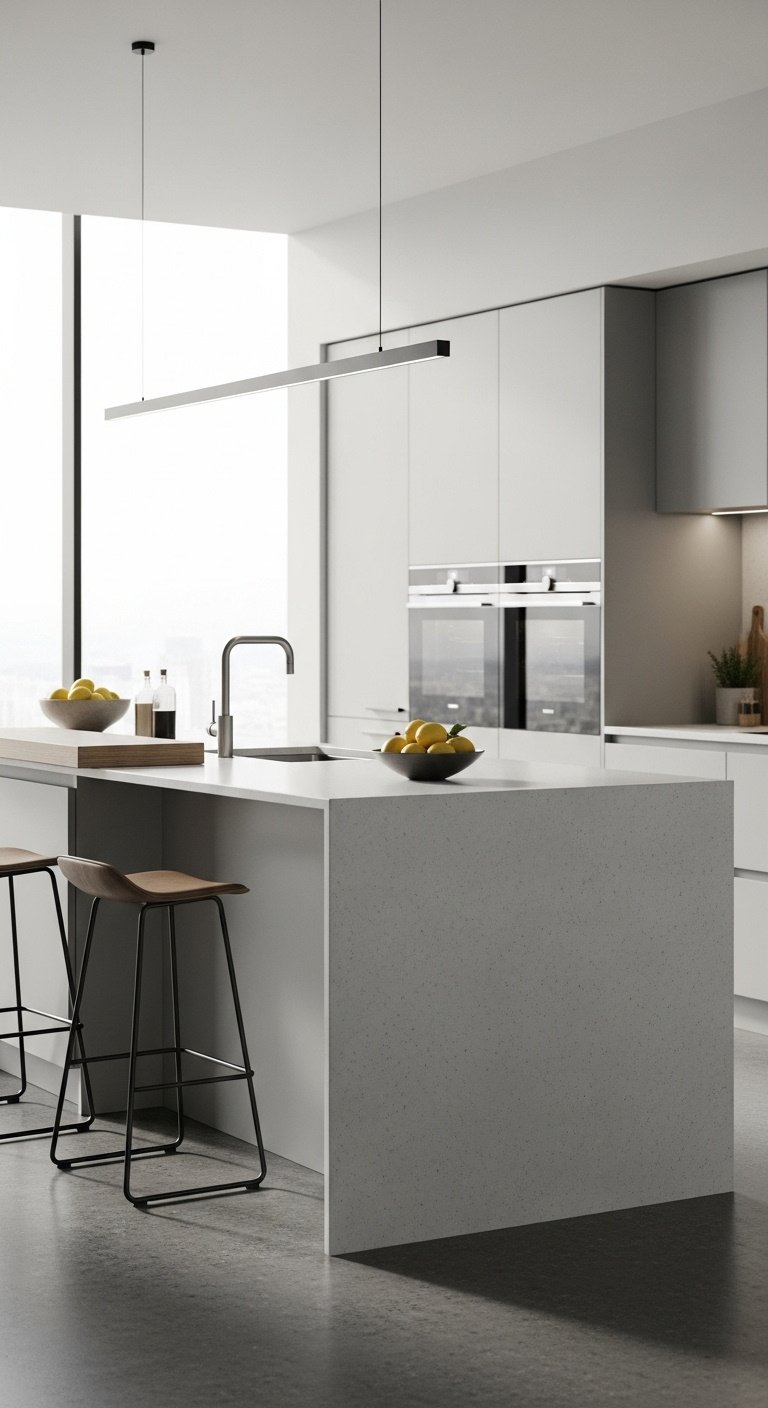
A single-wall kitchen with an island is an excellent solution for open-concept spaces and smaller homes. This layout uses the island to define the kitchen zone, adding crucial prep space, storage, and often casual dining without closing off the area.
- Materials Needed: Measuring tape, floor plan sketch, painter’s tape.
- Step-by-Step Directions:
- Measure Your Space: Calculate the total square footage of your open kitchen area. The island should not exceed 10% of this.
- Define the Zone: Use painter’s tape on the floor to mark out the island’s potential footprint.
- Check Clearances: Ensure there are 42-48 inches of clearance between the island and the main wall of cabinets, and on any other traffic-heavy sides.
- Assign a Primary Function: Decide if the island is for prep, cooking, or dining to determine if you need plumbing, electrical, or just a simple surface.
Pro-Tip: In smaller single-wall kitchens, consider a freestanding work table or a mobile cart instead of a fixed island. This adds character and provides ultimate flexibility.
Save this open-concept idea to your ‘Dream Kitchen’ board!
2. The Classic L-Shaped Kitchen with a Center Island
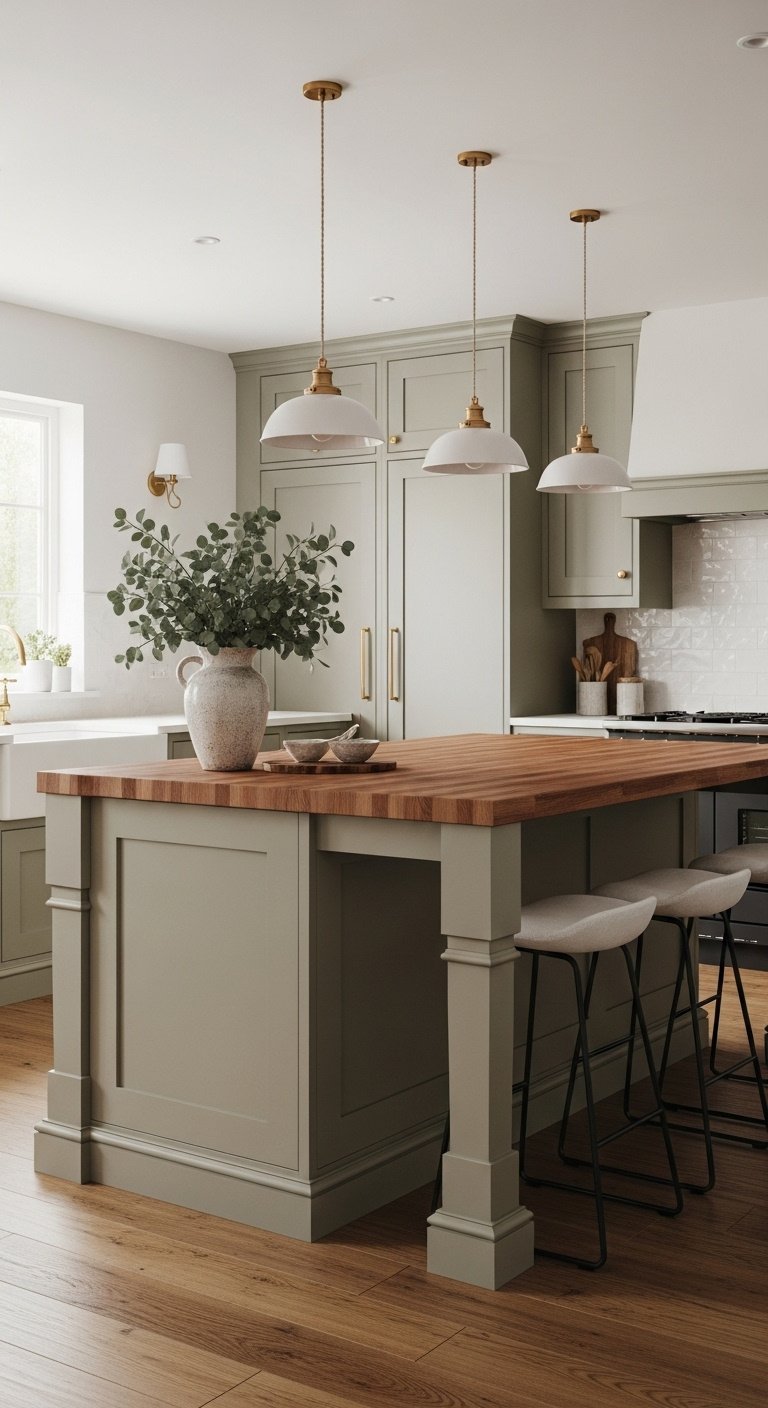
An L-shaped kitchen benefits from a center island by creating a highly efficient work triangle and a natural hub for social interaction. The island acts as a visual anchor and adds a huge amount of counter space without impeding the natural flow between the sink, refrigerator, and stove.
- Materials Needed: Floor plan, measuring tape, string.
- Step-by-Step Directions:
- Map the Work Triangle: Identify the locations of your fridge, sink, and stove. Use string to visualize the triangle on your floor plan.
- Position the Island: Place the island so it doesn’t obstruct any leg of the work triangle. The total length of the triangle’s sides should not exceed 20 feet.
- Optimize Flow: Position the island opposite the longer leg of the “L” to create a natural and efficient traffic path around the work zone.
- Plan Seating: If adding seating, ensure there’s at least a 15-inch countertop overhang for comfortable legroom.
Pro-Tip: For a unique look and improved flow in large L-shaped kitchens, consider placing the island on a diagonal. This can open up the space and create interesting visual lines.
Pin this perfect L-shaped layout for your renovation inspiration!
3. The Spacious U-Shaped Kitchen with an Internal Island
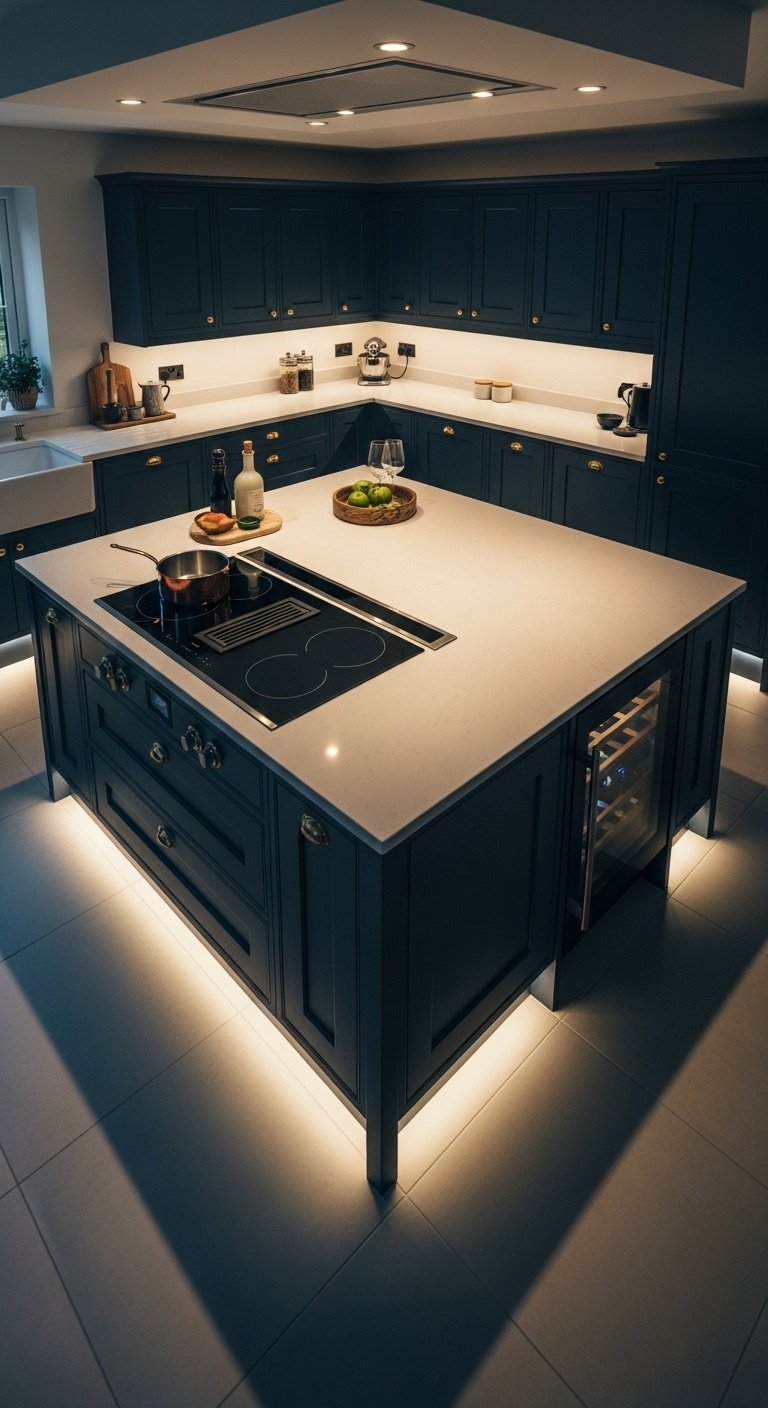
In a large U-shaped kitchen, an island adds a central workstation that makes the ample counter space more accessible and functional. This layout is ideal for multi-cook households, as it provides separate work zones and prevents the U-shape from feeling like a cavernous, underutilized space.
- Materials Needed: Measuring tape, cardboard for templating.
- Step-by-Step Directions:
- Measure the “U”: Ensure the open space inside the “U” is at least 10 feet wide to accommodate an island with proper clearances (42-48 inches on each side).
- Create a Template: Cut a large piece of cardboard to the proposed size of your island. Place it on the floor to physically test traffic flow and appliance door clearance.
- Consider an External Island: If the internal space is too tight, plan for the island to sit just outside the open end of the “U.” This creates a fourth wall dedicated to seating, keeping guests out of the primary work zone.
- Plan Utilities: If adding a cooktop or sink, consult with a plumber and electrician early to map out necessary lines before finalizing the location.
Pro-Tip: In a U-shaped layout, dedicating the island to prep space only (no appliances or sink) creates the most flexible and uncluttered work surface, perfect for large projects like baking or hosting a buffet.
Love this look? Save it to your ‘Luxury Kitchen Ideas’ board!
4. The Efficient Galley Kitchen with a Narrow Island
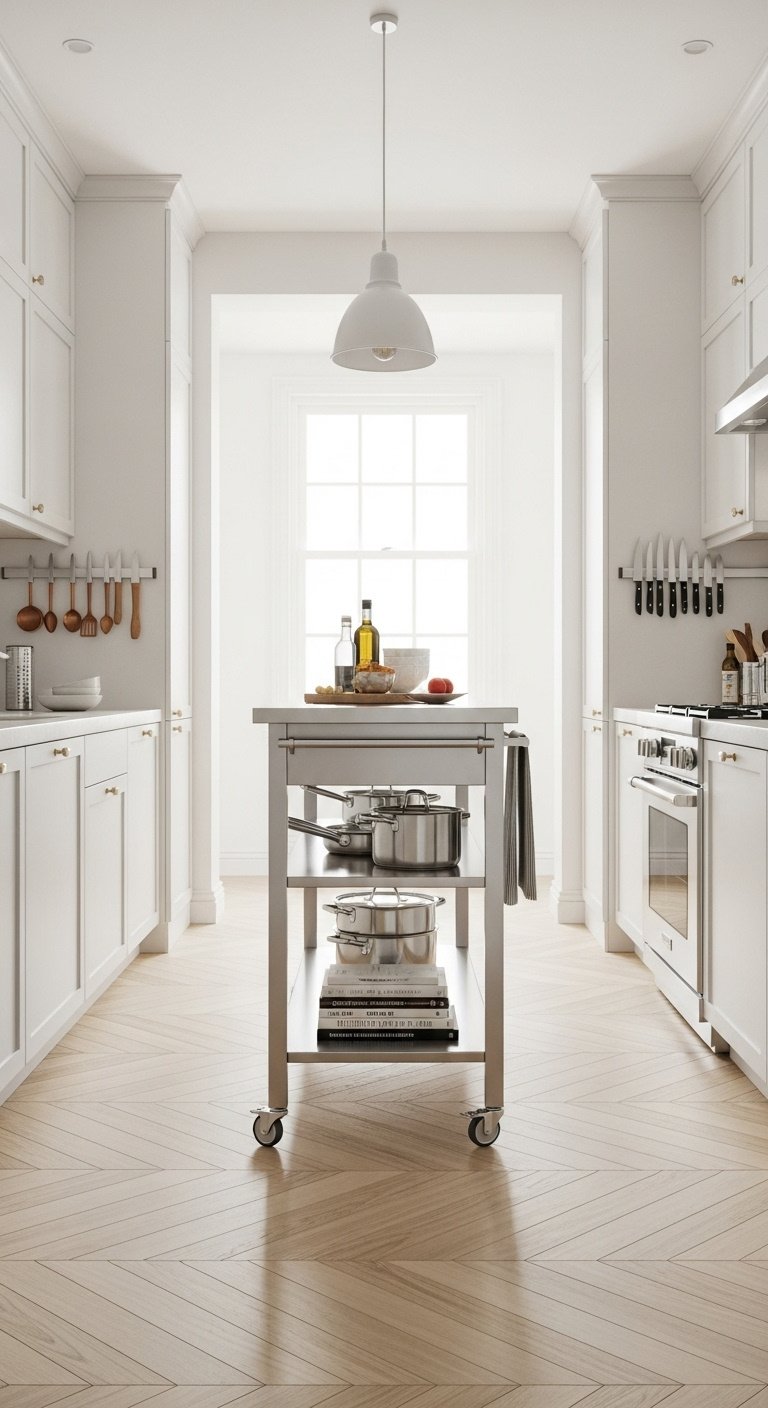
An island is possible in a galley kitchen if it’s a slim, narrow design or a mobile cart that adds workspace without creating a permanent obstruction. This is a smart solution for adding a much-needed landing spot and prep area in an otherwise constrained layout.
- Materials Needed: Measuring tape, knowledge of available space.
- Step-by-Step Directions:
- Confirm Width: A galley kitchen needs to be at least 12-13 feet wide to comfortably fit a narrow fixed island and maintain two 42-inch walkways.
- Calculate Island Width: If your galley is narrower, subtract your desired walkway clearance (minimum 36 inches, 42 is better) from the total width between cabinets. This gives you the maximum width for your island. A 24-inch wide island is often ideal.
- Explore Mobile Options: For any galley under 12 feet wide, a mobile cart or island is the best choice. This allows you to move it out of the way when needed.
- Prioritize Function: Decide what you need most: a landing spot for groceries, a small prep area, or storage. This will guide your choice between a simple butcher block cart or a more substantial island with drawers.
Pro-Tip: To make a narrow island feel less intrusive, choose one with open shelving or legs instead of a solid base. This allows you to see the floor underneath, creating an illusion of more space.
Pin this smart solution for your narrow kitchen space!
5. The Entertainer’s Dream: The Double Island Layout
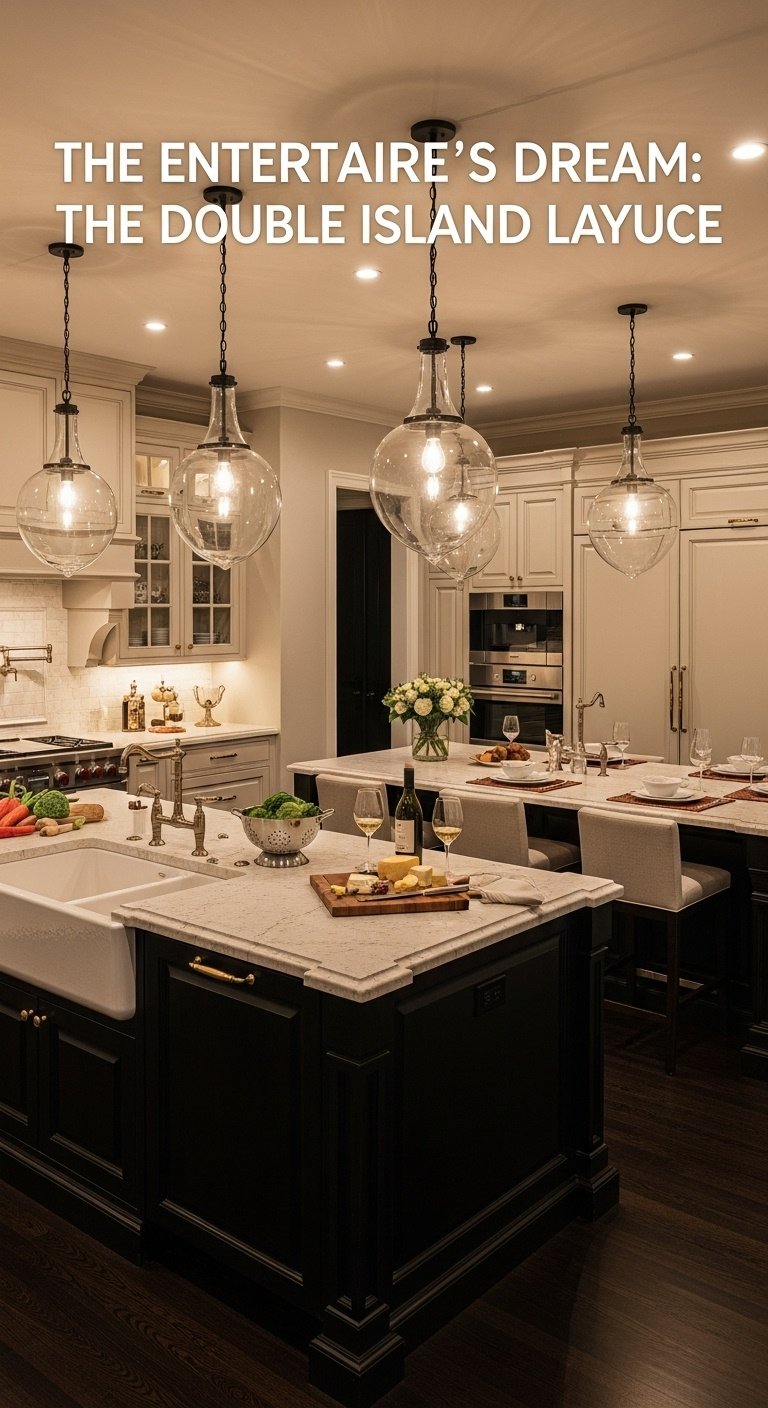
The double island layout is the ultimate luxury for large kitchens, creating two distinct zones: one for serious cooking and prep, and one for socializing and dining. This design offers unparalleled functionality and smooth traffic flow, allowing the host to work efficiently while still engaging with guests.
- Materials Needed: Professional design software or a kitchen designer, large floor plan.
- Step-by-Step Directions:
- Assess Your Space: This layout is only suitable for very large kitchens. You need enough space for two islands plus 42-48 inches of clearance around each one.
- Assign Roles: Clearly define the function of each island. One should be the primary “workhorse” with a sink, dishwasher, and prep space. The other should be the “social” hub for seating, serving, and homework.
- Orient for Flow: Typically, the islands are placed parallel to the main cabinet run. The work island should be closer to the primary cooking zone (range, fridge), while the social island acts as a buffer to the living or dining area.
- Harmonize Design: While their functions differ, the islands should have a cohesive design through matching countertop materials, cabinet colors, or hardware.
Pro-Tip: To create visual interest, consider making the two islands different heights. A standard counter-height (36″) work island paired with a slightly taller bar-height (42″) social island can create a dynamic, multi-level effect.
Save this ultimate kitchen goal to your ‘Entertaining at Home’ board!
6. The Space-Saver: The Peninsula Island
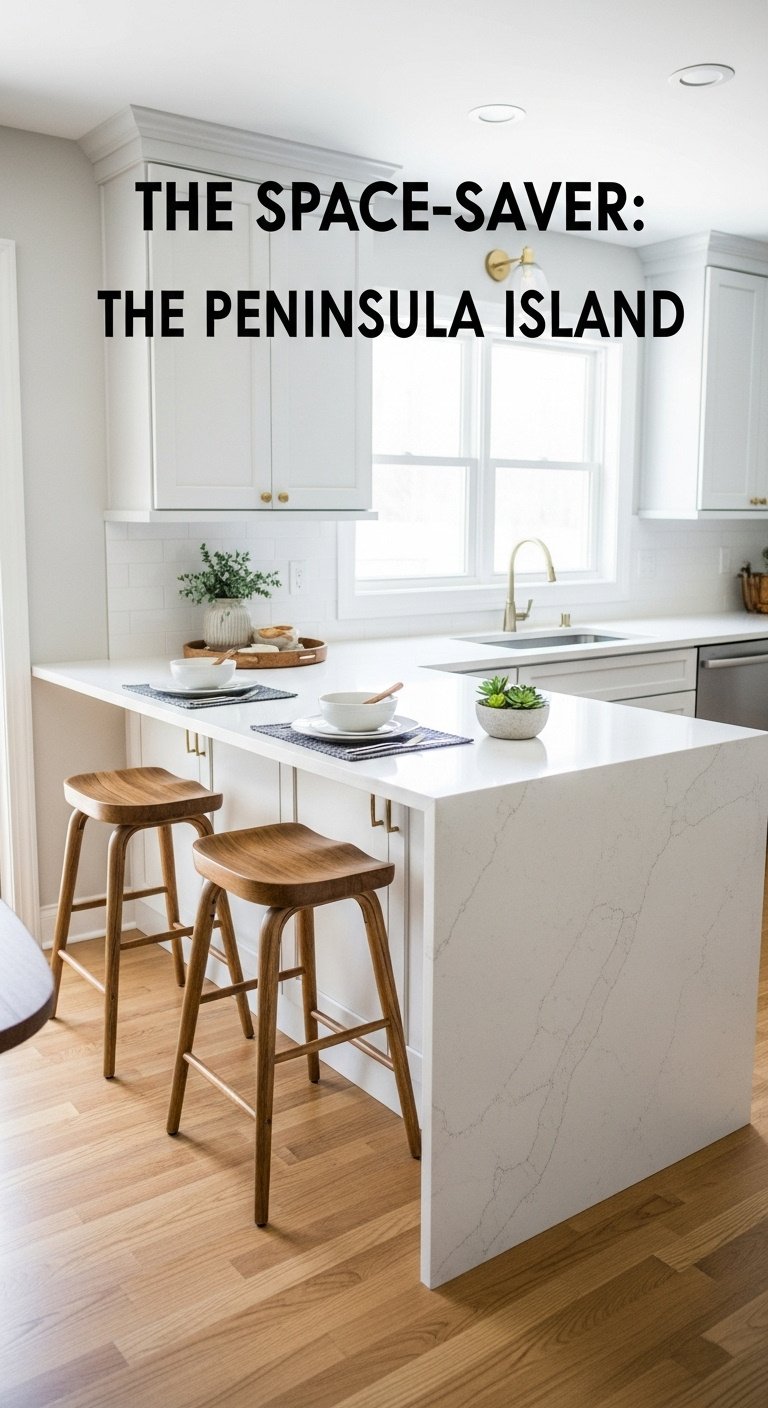
A peninsula is the perfect island alternative for kitchens that lack the space for a freestanding unit. By attaching to a wall, it provides all the benefits of an island—extra workspace, storage, and seating—while only requiring clearance on three sides, making it a brilliant space-saving solution.
- Materials Needed: Measuring tape, floor plan.
- Step-by-Step Directions:
- Identify the Anchor Wall: Choose a run of cabinets from which the peninsula will extend, typically creating an L or U-shape.
- Determine Length: The peninsula’s length depends on your needs. A 4-foot length can seat two people, while a longer one can define the kitchen space more strongly.
- Plan the Walkway: The key measurement is the opening into the kitchen. Ensure this walkway is at least 36-42 inches wide for comfortable access.
- Integrate Function: A peninsula is a prime spot for a sink or cooktop, which can free up other counter space. It’s also the most natural location for casual seating in a smaller kitchen.
Pro-Tip: Avoid placing the refrigerator directly opposite the end of the peninsula. This can create a major traffic jam when the fridge door is open.
Perfect for smaller spaces! Pin this peninsula idea now!
7. The T-Shaped Island: A Hybrid for Work and Dining
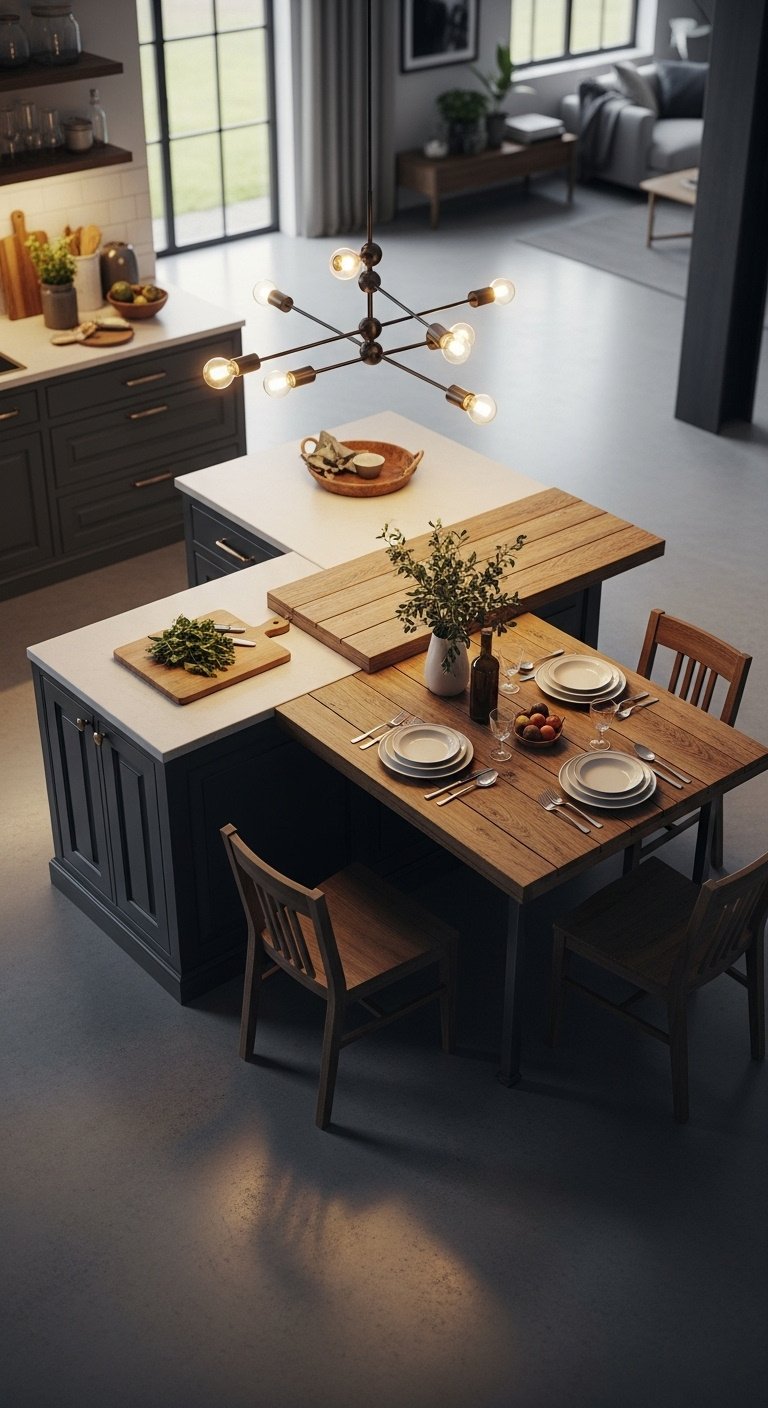
A T-shaped island is a clever hybrid design that seamlessly integrates a functional work zone with a dedicated dining table. This is perfect for homeowners who want to combine kitchen prep with a comfortable, family-style seating area without needing a separate breakfast nook.
- Materials Needed: Kitchen designer, detailed floor plan.
- Step-by-Step Directions:
- Evaluate Space: This design requires a significant amount of floor space to accommodate the ‘T’ extension and chairs while maintaining clear walkways.
- Define Heights: Determine the two levels. The work section is typically standard counter height (36 inches), while the dining section is table height (30 inches) for use with standard dining chairs.
- Plan the Intersection: The design of the intersection is crucial. Ensure the dining table portion is securely attached to the island base for stability.
- Allocate Space per Person: For the dining section, allow 24 inches of width and 18 inches of depth for each place setting to ensure comfortable seating.
Pro-Tip: Use contrasting materials to visually separate the two zones. A quartz or granite work surface paired with a warm wood dining table creates a beautiful and functional distinction.
Save this innovative T-shaped island to your ‘Kitchen Design’ board!
8. The Curved Island: Softening the Edges
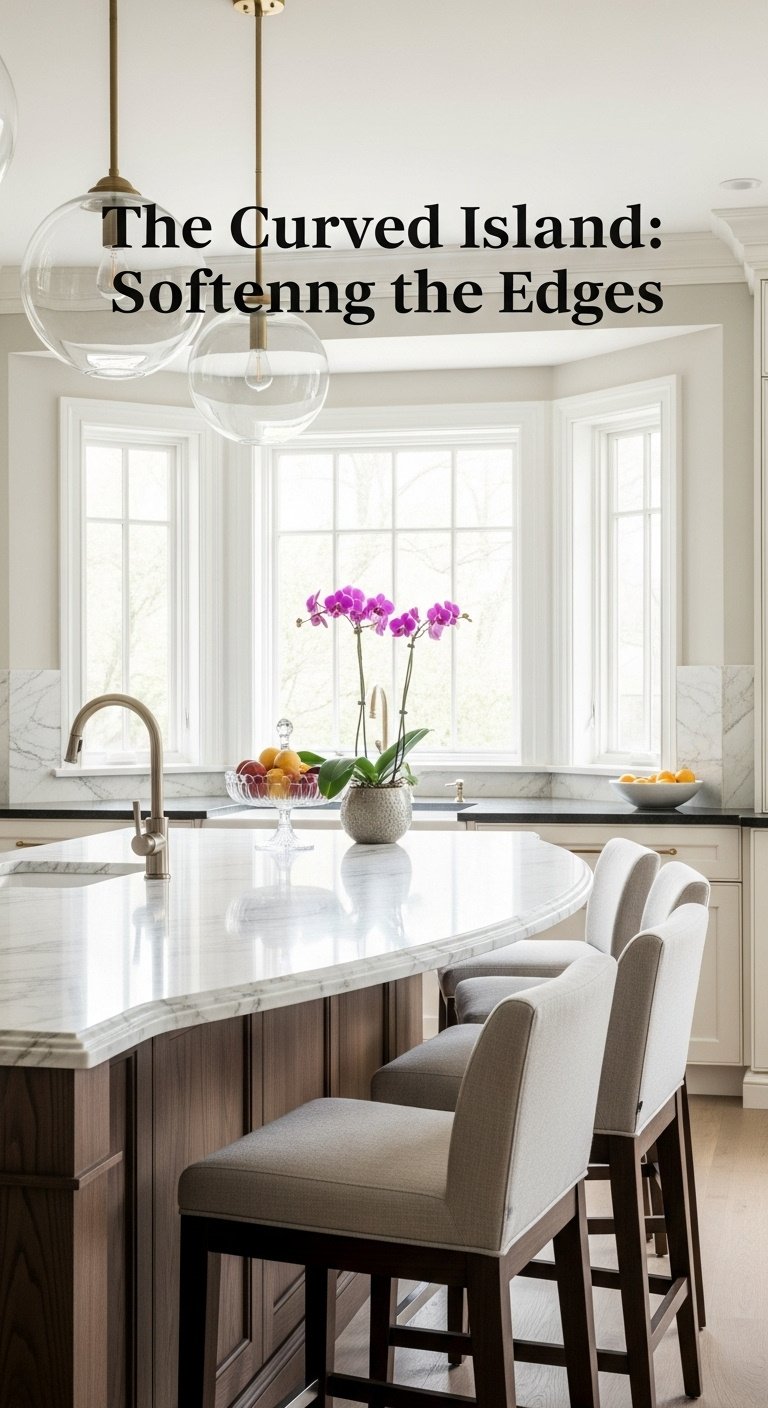
A curved island is a stylish way to soften the hard lines of a kitchen, improve traffic flow around corners, and create a more social seating arrangement. The gentle arc is visually appealing and can make a space feel more organic and inviting.
- Materials Needed: Custom cabinet maker, countertop fabricator.
- Step-by-Step Directions:
- Consider Traffic Patterns: A curved island is excellent for easing flow around tight corners or guiding traffic through a space. Sketch your primary paths to see where a curve would be most effective.
- Plan Seating: The outer curve is the natural spot for seating, as it encourages conversation by allowing guests to face each other slightly.
- Choose Your Curve: Decide between a gentle arc, a half-moon shape, or a more complex free-form curve. This will impact cost and complexity.
- Budget for Customization: Curved islands require custom cabinetry and countertop fabrication, which is more expensive than standard rectangular designs. Factor this into your budget early.
Pro-Tip: For custom curved islands, countertop material is key. Materials like quartz, solid surface (Corian), and some natural stones can be fabricated into smooth curves more easily than materials like laminate or wood butcher block.
Pin this elegant curved island for a touch of unique style!
9. The Work Table Island: A Rustic and Flexible Alternative
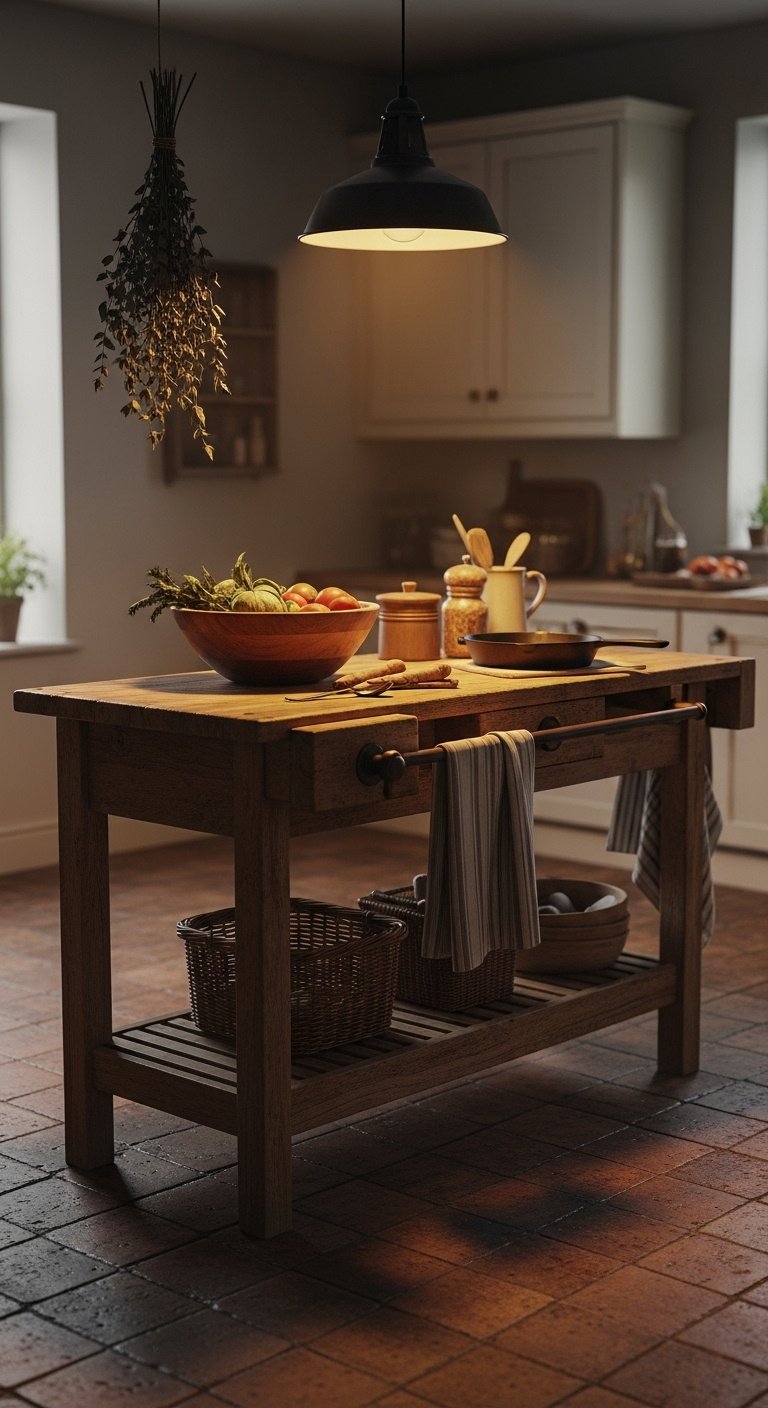
Using a freestanding work table as an island is a flexible, character-rich alternative to a traditional built-in unit. It adds a rustic, “unfitted” look, makes the kitchen feel more open and airy, and can be easily moved or swapped out as your needs change.
- Materials Needed: A vintage table, measuring tape, food-safe sealer (if needed).
- Step-by-Step Directions:
- Measure for Height: The ideal height for a work table island is counter-height, around 36 inches. If your chosen table is shorter, you can add casters or have a woodworker add extensions to the legs.
- Assess the Surface: If the tabletop will be used for food prep, ensure it’s a non-porous material or seal it with a food-safe finish like butcher block oil or a polyurethane sealer.
- Add Functionality: Enhance the table with a pot rack overhead, hooks on the side for utensils, or baskets on a lower shelf for storage.
- Consider Mobility: Adding locking casters makes the table easy to move for cleaning or to reconfigure the space for a party.
Pro-Tip: Flea markets, antique stores, and even restaurant supply stores are fantastic sources for unique work tables. Look for sturdy construction and a size that fits your kitchen’s proportions.
Get the 2025 look! Save this work table island trend to your boards.
10. The Island with a Built-in Banquette
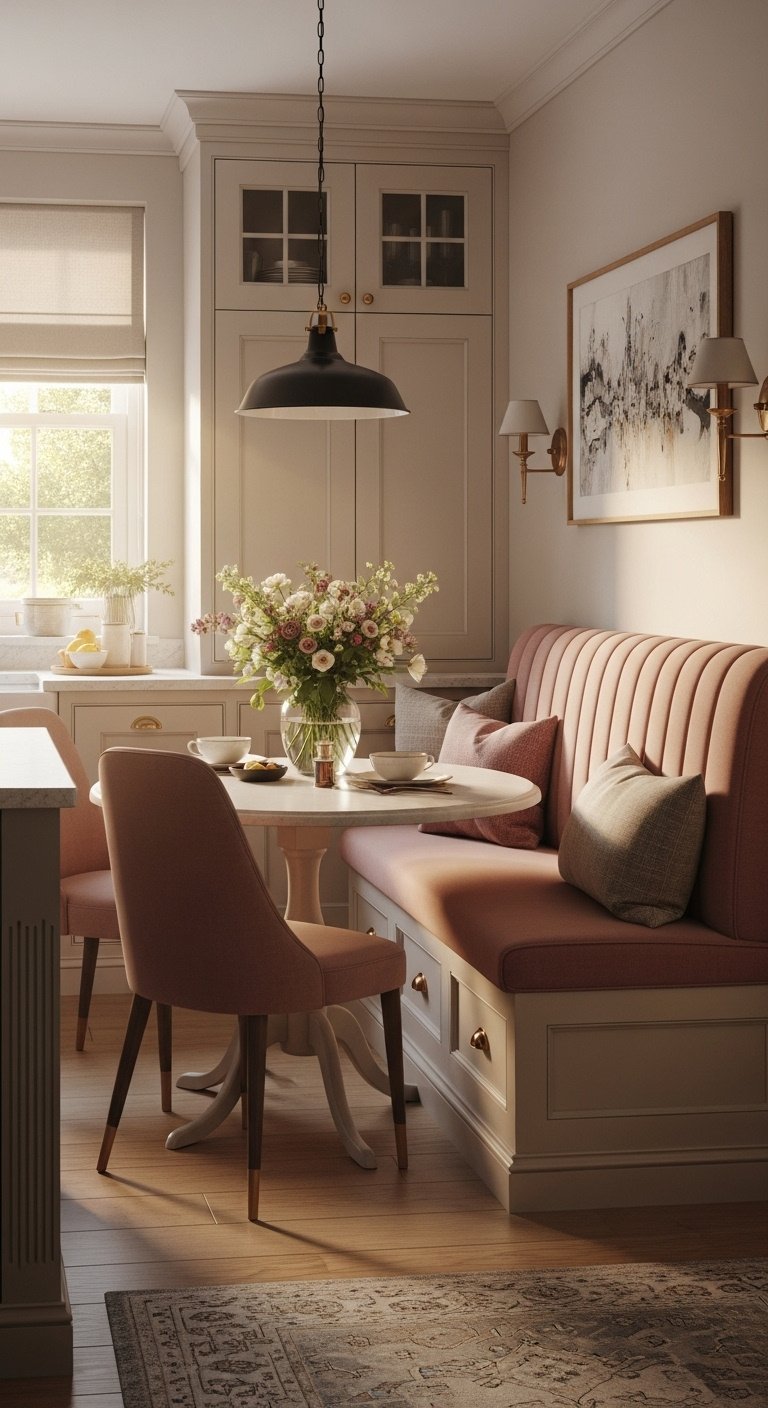
An island with built-in banquette seating is a genius, space-saving design that combines a prep zone with a cozy breakfast nook. This custom solution is perfect for eat-in kitchens, maximizing seating in a small footprint while often providing hidden storage under the bench.
- Materials Needed: Custom cabinet designer, upholsterer, dining table.
- Step-by-Step Directions:
- Design Integration: Plan the banquette as an integral part of the island’s construction from the beginning. It should flow seamlessly from the cabinet base.
- Standard Seating Dimensions: Design the bench to be 18 inches high (standard seat height) and 18-20 inches deep for comfort.
- Incorporate Storage: The space under the banquette bench is perfect for hidden storage. Plan for either lift-up tops or pull-out drawers.
- Choose a Table: Pair the banquette with a pedestal table or a table with legs set inward. This makes it much easier to slide in and out of the bench without hitting table legs.
Pro-Tip: Use a high-performance, stain-resistant fabric for the banquette upholstery. Fabrics designed for outdoor use are often a durable and easy-to-clean choice for a high-traffic kitchen area.
Save this genius space-saving banquette idea for your family kitchen!
11. The Minimalist Waterfall Island
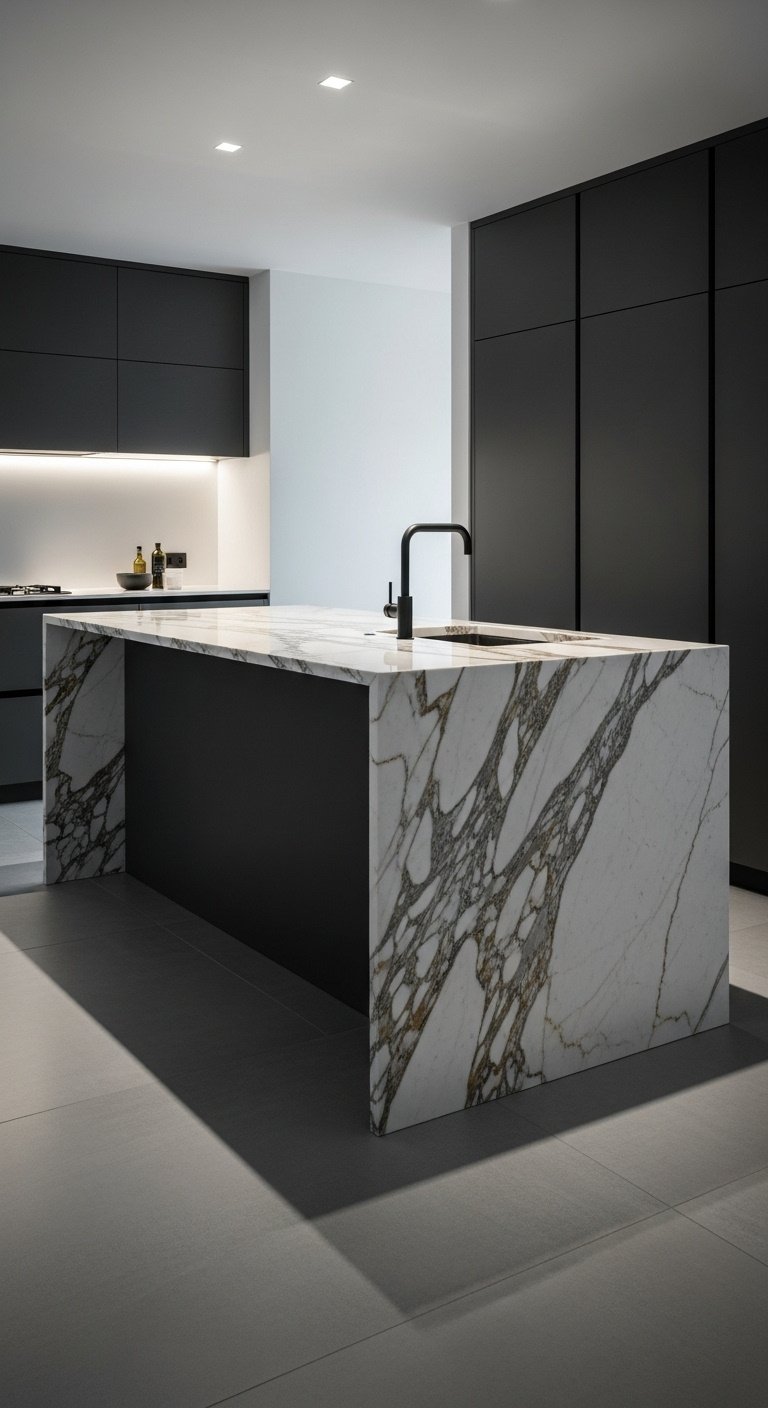
A waterfall island is a high-impact, architectural statement piece for a modern kitchen. This design, where the countertop material flows seamlessly down the sides to the floor, turns the island into a sculptural focal point, perfect for minimalist and luxurious aesthetics.
- Materials Needed: High-end countertop fabricator, budget for premium materials.
- Step-by-Step Directions:
- Select a Material with Impact: This design is all about the material. Choose a stone or quartz with dramatic veining, like Calacatta marble or a bold quartz pattern.
- Plan for Bookmatching: For the most seamless and high-end look, ask your fabricator to “bookmatch” the slabs, where the vein patterns on the top and sides mirror each other.
- Specify Mitered Edges: Ensure your fabricator uses a mitered edge at the corners. This creates a clean, sharp 90-degree angle where the material looks like a single, solid block.
- Keep it Simple: The beauty of a waterfall island is its form. Avoid cluttering it with too many appliances. An undermount sink and a sleek induction cooktop are ideal choices.
Pro-Tip: A waterfall island is a significant investment. To protect the vertical edges in a high-traffic area, consider a “floating” design where the base is slightly recessed, lifting the waterfall edge off the floor by an inch or two.
Pin this statement-making waterfall island for a modern kitchen design!
Key Takeaways: Your Quick Guide to kitchen layouts with island
- Function First: Always define the island’s primary purpose (prep, cooking, seating, storage) before choosing a size or shape.
- The Clearance Rule: The most critical measurement is clearance. Aim for 42-48 inches of open walkway on all working sides for a comfortable and safe workflow.
- Proportion is Key: A good rule of thumb is that an island should not take up more than 10% of the total kitchen square footage.
- Mind the Triangle: Your island should not obstruct the natural path between the sink, stove, and refrigerator.
- Think Beyond the Rectangle: For small spaces, consider mobile carts or peninsulas. For large spaces, explore double islands or T-shapes for maximum functionality.
People Also Ask About kitchen layouts with island
What is the most efficient kitchen layout with an island?
The L-shaped kitchen with a center island is often considered the most efficient. This layout naturally supports an effective work triangle (the path between sink, stove, and fridge) and the island enhances it by providing a central prep station without blocking traffic flow. It creates a highly functional and social hub suitable for most medium to large kitchens.
What is the new trend replacing the kitchen island for 2025?
For 2025, the biggest trend challenging the traditional built-in island is the freestanding “work table.” Often a vintage or antique piece, this alternative adds character, warmth, and flexibility to the kitchen. It provides an open, airy feel compared to a blocky cabinet-based island and can be easily moved or replaced, appealing to those who want a less permanent, more curated look.
What is the rule of thumb for a kitchen island?
The primary rule of thumb for a kitchen island involves two key measurements. First, ensure there is adequate clearance of at least 42-48 inches around the island for safe traffic flow and appliance access. Second, the island’s size should be proportional to the room, generally taking up no more than 10% of the kitchen’s total square footage to avoid overwhelming the space.
Final Thoughts
A kitchen island is more than just extra counter space; it’s the heart of your home where meals are prepped, conversations are had, and memories are made. By choosing a layout that fits your space and your lifestyle, you’re not just designing a kitchen—you’re creating a hub for daily life. Which of these layouts sparked an idea for your own home? Let us know in the comments below
